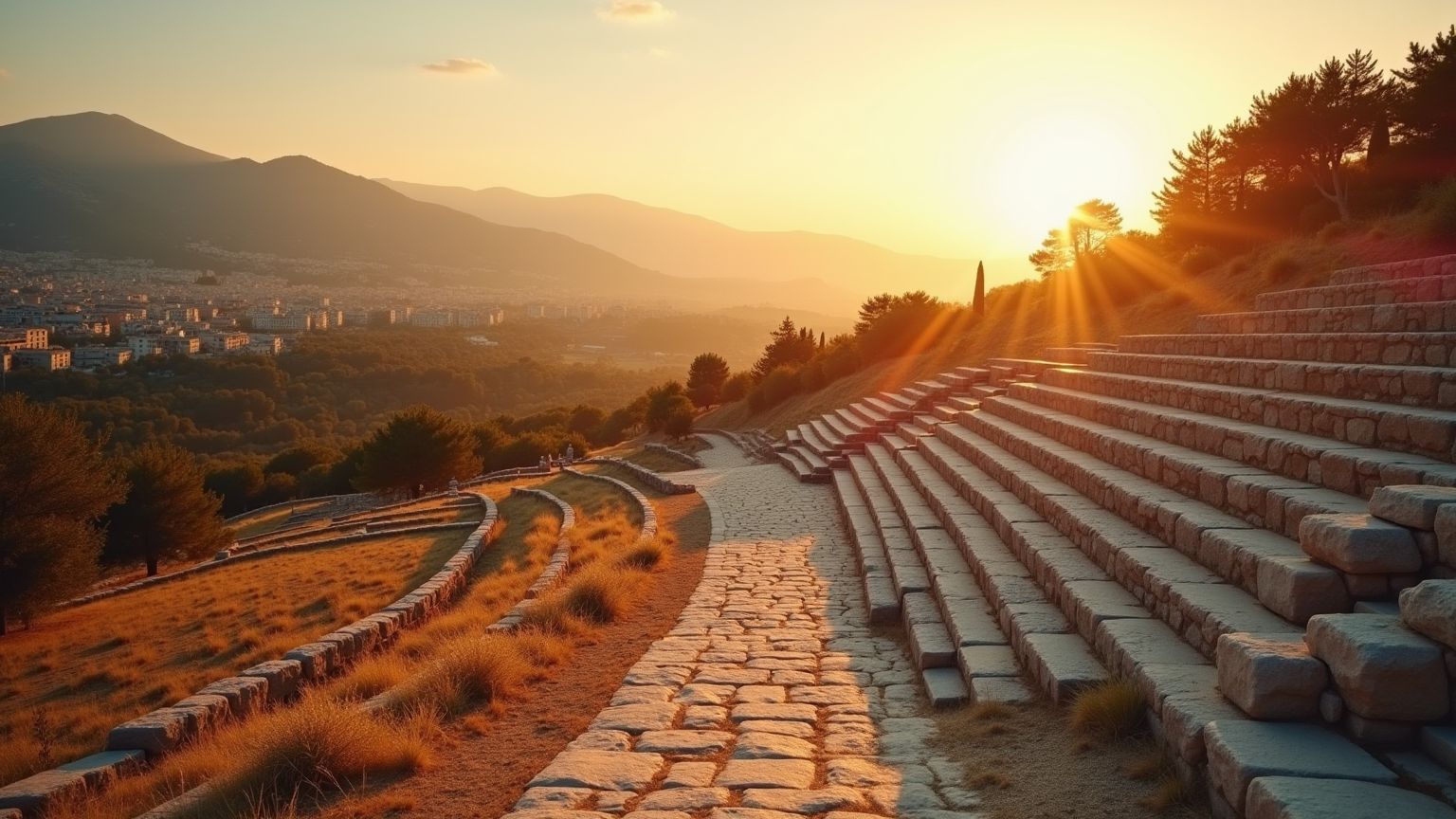Exploring Ancient Messini: A Local Guide to Greece’s Hidden Archaeological Gem
After 20+ years showing folks around the Peloponnese's ancient treasures, I've watched way too many visitors zip right past Ancient Messini to hit the "postcard sites" like Olympia or Mycenae. Let me set you straight - this sprawling ancient city isn't just worth a quick stop; it might end up being the highlight of your entire Greek adventure.
The Hidden Marvel of the Peloponnese

Tucked away in Mount Ithome's foothills in the southwestern Peloponnese, Ancient Messini (sometimes spelled Messene in archaeological texts) stands as Greece's best-kept secret. While tourists elbow each other for photos at the Acropolis, here you'll often find yourself alone among magnificent ruins with just olive trees whispering and cicadas providing your soundtrack.
I still chuckle remembering my first tour group back in '03. As we wound through those mountain roads, this skeptical American guy grumbled, "We're driving all this way for what exactly?" Three hours later, he was dragging his feet to leave, confessing it was the most mind-blowing ancient city he'd encountered anywhere in the Mediterranean.
What makes Ancient Messini so special isn't just individual impressive buildings - it's the completeness. You can actually trace street layouts, visualize neighborhoods, and understand how everyday life functioned. It's like ancient Greece in 3D rather than fragments.
A Brief History: Freedom After Centuries of Slavery
The backstory of Ancient Messini adds serious emotional weight to your visit. The Messenians weren't just building another city - they were celebrating their freedom after generations of brutal existence as Spartan helots (basically state-owned slaves).
After the Thebans crushed Sparta at Leuctra in 371 BCE, the brilliant general Epaminondas helped these formerly enslaved people establish their independence and build a capital worthy of their new-found dignity.
Every stone at Ancient Messini tells this freedom story. Those massive city walls weren't just for defense - they were psychological barriers against their former Spartan masters. Walking the site today, you're literally tracing the footsteps of people who knew exactly what liberty cost.
What to See: Highlights of Ancient Messini
The Stadium and Gymnasium Complex
The beating heart of Ancient Messini is its jaw-dropping stadium-gymnasium complex. Unlike Olympia (which has been substantially rebuilt), Messini's stadium remains wonderfully authentic - original stone seating, starting blocks still in place after 23 centuries.
The connected gymnasium features columns standing exactly where ancient builders placed them. Visit in morning light and watch as the sun creates dramatic column shadows that'll have photographers in your group getting downright giddy.
What truly sets this area apart is seeing how Ancient Messini's citizens brilliantly integrated athletic training, competition and education into one architectural space. Spring visitors get an added bonus: wild poppies and other wildflowers sprouting between ancient stones create scenes that look straight out of a romantic painting.
The Theater
Though not as massive as some Greek theaters, Ancient Messini's performance space packs a stunning acoustic punch. Stand center-stage and speak normally - your friends sitting 15 rows up will hear every syllable perfectly. I never tire of watching visitors' jaws drop during this impromptu sound demonstration.
Recent archaeological work uncovered gorgeous marble reliefs showing theatrical masks and mythological scenes. Some remain displayed right at the theater site, while others have moved to the museum collection.
The Asklepieion (Healing Sanctuary)
Ancient Messini's Asklepieion wasn't just a healing temple - it functioned as downtown Central Square where everything from political debates to religious ceremonies unfolded. Surrounded by impressive Doric columns, this vast space housed temples, meeting halls, and public buildings.
Most visitors find themselves fascinated by how the Asklepieion reveals everyday civic life in Ancient Messini. This wasn't just a spiritual center but the physical heart where Messenian democracy happened. The stones here have witnessed everything from heated political arguments to joyous festivals.
The Fortification Walls and Arcadian Gate
Ancient Messini boasts some of the Mediterranean's most impressive city walls. Stretching nearly 9 kilometers, these massive fortifications include towers and gates that would make military engineers gape even today.
The showstopper is definitely the Arcadian Gate - a double circular entrance designed to let two chariots pass simultaneously. It stands in remarkable condition, its massive stone archway intact after millennia. Climb to the top (as I always encourage my groups) for sweeping views across olive groves and mountains that have barely changed since ancient times.
The On-Site Museum
After exploring Ancient Messini's sun-drenched ruins, duck into the excellent museum housing excavation finds. Unlike museums that overwhelm with endless artifacts, Ancient Messini's collection thoughtfully presents key pieces that tell the city's story.
The marble statues particularly impress me - they show sophisticated artistic standards maintained in what was essentially a provincial city. Many depict local notables, giving faces to the ancient Messenians who built this remarkable place.
Planning Your Visit to Ancient Messini
Getting There
Ancient Messini sits about 30km northwest of Kalamata. From Athens, plan for roughly a 3-hour drive. From other Peloponnese hotspots like Olympia or Nafplio, expect about 2 hours behind the wheel.
Public transport options? Limited, honestly. Your best bet is grabbing a KTEL bus from Athens or Kalamata to modern Messini town, then negotiating a taxi to the archaeological site. Most visitors find renting a car gives them the freedom Ancient Messini deserves.
The journey itself offers spectacular scenery cutting through Peloponnesian mountains and valleys. Those winding roads might challenge nervous drivers, but they're well-maintained and worth every curve for the views they deliver.
When to Visit Ancient Messini
After guiding here through all seasons, I'd stake my reputation on spring (April-May) and autumn (September-October) offering the most magical conditions. Spring brings Ancient Messini alive with wildflowers, while autumn offers crystal-clear skies and comfortable exploring temperatures.
Summer visits? Certainly doable but prepare for serious heat between 11AM-4PM. If summer's your only option, arrive when gates open at 8AM and bring:
- Plenty of water (at least 1 liter per person)
- Serious sun protection (hat, sunscreen, sunglasses)
- Perhaps a portable umbrella for instant shade
Winter visits to Ancient Messini create a wonderfully moody atmosphere with dramatically cloudy skies photographers adore. Pack for potential rain and cooler temps, though the site rarely closes for weather.
Practical Tips from a Local Guide
After bringing hundreds of visitors to Ancient Messini over two decades, I've developed some hard-earned wisdom:
Time allocation is crucial: Most tour companies rush through in 2 hours - barely enough to see highlights. Independent travelers should plan 3-4 hours minimum to truly appreciate Ancient Messini's scale and details.
Footwear matters enormously: The site covers serious ground with uneven surfaces. I've watched too many visitors in flimsy sandals or fashion shoes struggling miserably. Wear sturdy walking shoes with proper grip.
Site facilities are minimal: Bring water, snacks, sun protection and a hat. Ancient Messini has some shaded areas, but many of its most impressive sections offer zero escape from direct sun.
Consider hiring a local guide: While information panels provide context, a knowledgeable guide transforms your understanding of Ancient Messini. The site office can often arrange local experts with advance notice.
Make it a full day: Combine Ancient Messini with nearby attractions like the Palace of Nestor at Pylos or the charming seaside town of Koroni for a perfect Peloponnesian day.
Don't skip the modern village: The picturesque village of Ancient Messini (Αρχαία Μεσσήνη) sits right next to the archaeological site. Its tavernas serve ridiculously good local cuisine - perfect for post-exploration refueling.
The Experience Beyond the Ruins
What truly sets Ancient Messini apart isn't just impressive architecture but the immersive experience of wandering a complete ancient Greek city without the tour bus crowds plaguing famous sites.
Here you can actually sit alone on stadium benches, imagining athlete's footsteps and spectator roars. You can stand center-stage in the theater, reciting a bit of Homer, hearing your voice project exactly as ancient performers experienced it. You can trace your fingers along those massive freedom-symbolizing walls.
On quiet afternoons at Ancient Messini, especially during shoulder seasons, the site feels like your personal time machine. The quality of light here - crystalline in the mountain air - creates photography opportunities that'll fill your memory cards, especially during golden hours.
A Personal Reflection
After countless visits over twenty years, Ancient Messini continues surprising me. Each visit reveals some architectural detail, historical connection, or perfect viewing angle I somehow missed before. It's a site rewarding repeated visits and careful observation.
What moves me most about Ancient Messini isn't just architectural grandeur but the human story embedded in those stones - a people who, after generations under brutal oppression, created one of the ancient world's most magnificent cities. Their triumph echoes across millennia, speaking to something deeply human: our endless hunger for freedom, dignity, and self-expression.
When you visit Ancient Messini, you're not just checking another archaeological box. You're stepping into a powerful narrative of human resilience that continues inspiring 2,300 years later.
The ancient Messenians built their city to stand eternally. Against remarkable odds, much of Ancient Messini has survived—waiting for you to discover its stories, absorb its beauty, and carry its inspiration back into our modern world.
🏺 Discover Ancient Greece With Expert Guides
Transform your historical knowledge into unforgettable archaeological experiences
Historical Tours
UNESCO Archaeological Sites
Peloponnese Tours
25+ Local Experiences
Adventure Tours
Outdoor Activities








